Statue of “David” by Michelangelo – A Detailed Analysis
Why is the statue of David by Michelangelo so significant? What is the statue of David holding? And how tall is the statue of David? If you are a lover of Michelangelo sculptures, then you will surely appreciate the world’s most loved statue – David! The renowned sculptor and architect was one of the most celebrated artists in Western art history who left behind many masterpieces, including the sculpture of David. In this article, we will introduce you to all you need to know about the statue of David, as well as some thought-provoking facts about the High Renaissance master’s most famous sculpture!
Contents
- 1 Examining Michelangelo’s David: A Masterpiece of the High Renaissance
- 2 The Statue of David by Michelangelo
- 3 Copies of Michelangelo’s David
- 4 Unveiling Interesting Facts About Michelangelo’s David
- 5 Frequently Asked Questions
- 5.1 Who Created the Original Statue of David?
- 5.2 What Is the Statue of David by Michelangelo Made From?
- 5.3 Where Is the Statue of David Located?
- 5.4 How Tall Is the Statue of David by Michelangelo?
- 5.5 What Is the Statue of David Holding?
- 5.6 Which Las Vegas Hotel Features a Replica of the Statue of David?
Examining Michelangelo’s David: A Masterpiece of the High Renaissance
The statue of David is one of the most famous sculptures produced by one of the world’s best-known sculptors of the Italian High Renaissance, Michelangelo di Lodovico Buonarroti Simoni. Better known as Michelangelo, the Italian sculptor, painter, and architect was a leader in the field of sculpture, whose legacy remains Not only an iconic part of art history but has left an indelible mark on the generations that followed. Aside from his mastery over multiple mediums and art forms, he was also famous for creating the Michelangelo statue of David, which depicts a biblical hero in striking detail. The Italian masterpiece is a towering statue of the biblical figure, David, as inspired by the Christian bible and the story of David and the giant, Goliath. The 17-foot marble statue was executed with such fine workmanship that it has been dubbed one of the greatest sculptural works of the 16th century.
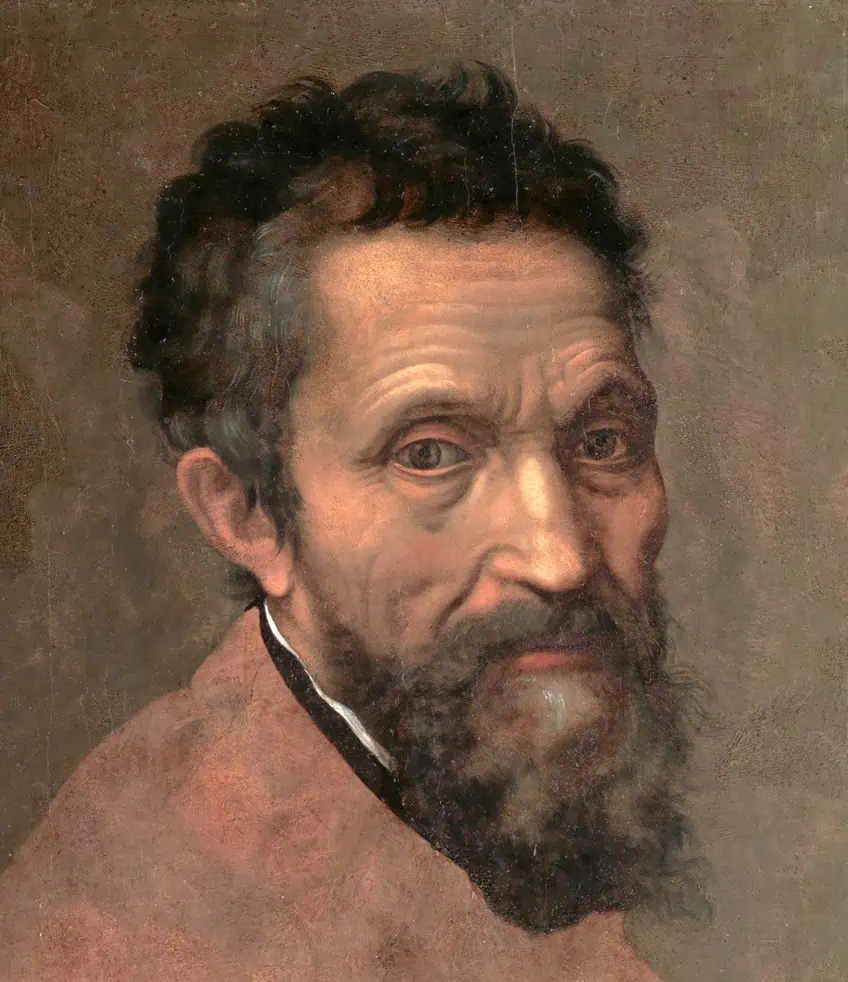
So, who was Michelangelo? Born Michelangelo Buonarroti, the Italian artist and poet was raised in modern-day Caprese Michelangelo, and later in Florence, to a family of bankers. At the time that Michelangelo was born, his father took up a post as a judicial administrator for a small commune called Chiusi della Verna. The Michelangelo family believed that they were descendants of Countess Matilde di Canossa, also known as la Gran Contessa or Matilda of Tuscany, who was historically one of the most prominent leaders of the Italian Middle Ages, yet the claim remains unproven. Michelangelo lost his mother when he was six years old and was first exposed to marble at a quarry that his father owned in a town called Settignano. It was here that Michelangelo was first inspired by the medium of marble.
From an early age, Michelangelo showed no interest in his academic education, rather, he preferred to make copies of paintings from other painters and associate mostly with artists, which was a behavior considered “well beyond his years”. During the late 15th century, the city of Florence had established itself as one of the largest centers of Arts and Culture in Europe. As such, the arts were sponsored by the town council of Signoria, including a few wealthy patrons such as the Medici family and other banking partners. During the Renaissance, the world saw a revival of a preference for classical education, which influenced the arts and inspired many artists to pursue classical subjects. Lorenzo Ghiberti was a pioneering sculptor of the early 15th century who later inspired Michelangelo in sculpture by creating the 50-year sculpture project on the Gates of Paradise.
Other leading artists of the proto-Renaissance who inspired Michelangelo included Masaccio and Giotto.
The Statue of David by Michelangelo
| Artist Name | Michelangelo di Lodovico Buonarroti Simoni (professionally known as Michelangelo) (1475 – 1564) |
| Date | 1501 – 1504 |
| Art Period | Italian High Renaissance |
| Medium | Marble |
| Dimensions (cm) | 517 x 199 |
| Weight (lb) | 12,000 |
| Where It Is Housed | Galleria dell’Accademia, Florence, Italy |
The statue of David by Michelangelo is one of the most famous sculptures of all time, which is also roughly the size of a giraffe. There are many interesting facts about the statue of David, but for now, we will dive into the structure of the statue as well as the process by which it was made. Later, we will look at a few interesting facts that you may find surprising about the Michelangelo David statue!
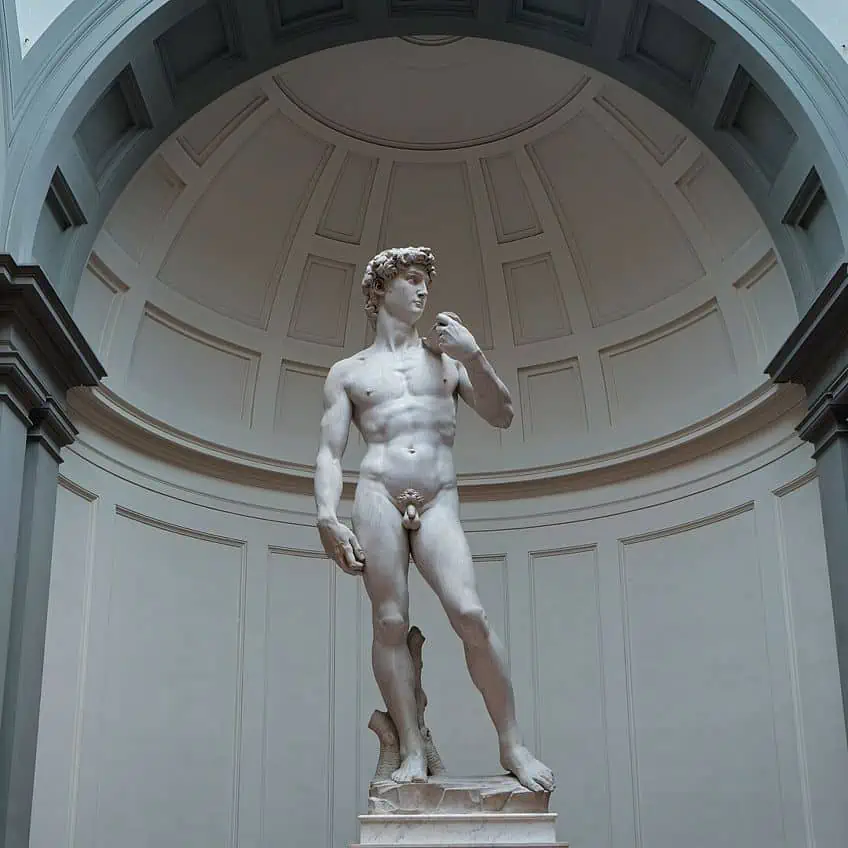
“no other artwork is equal to it in any respect, with such just proportion, beauty and excellence did Michelangelo finish it”. These famous words were penned by Giorgio Vasari who was one of the Italian Renaissance’s most famous art historians. Vasari mentions many prominent sculptors and artists, including Giotto and Michelangelo in his famous book The Lives of the Most Excellent Painters, Sculptors, and Architects. Additionally, Vasari’s texts and notes as an art historian and art critic are regarded as one of the most important contributions to Italian Renaissance art criticism. According to Vasari, Michelangelo’s statue of David was considered perhaps the most famous statue in all of Greece and the world.
Considering that this critique was coming from a critic who has witnessed masterworks by other leading artists before Michelangelo, one can attest to Vasari’s wise judgment.
The Making of Michelangelo’s David
So, how did this famous statue come to be? The Michelangelo statue of David was sculpted from marble between 1501 and 1504 and portrays a biblical character called David, standing in a powerful heroic pose in the nude. The sculpture was commissioned in the early 16th century by a group of officials known as the Opera del Duomo, who was in charge of managing the Cathedral of Florence. The Opera del Duomo commissioned Michelangelo to create a sculpture of David, which was originally intended for placement in the cathedral’s tribunes.
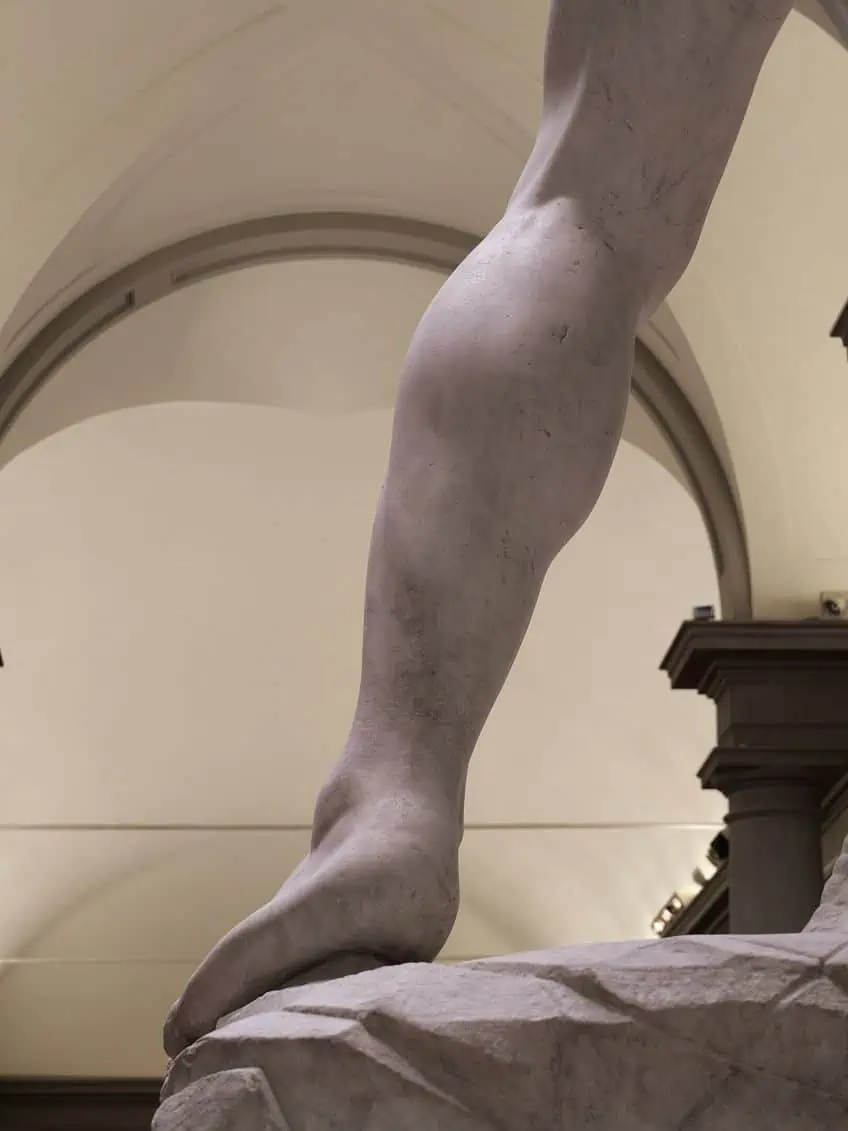
Michelangelo was not the first artist to attempt a statue of David for the church; many other artists tried to create sculptures from large blocks of marble but failed to execute them properly without imperfections called taroli. The project was then handed over to Michelangelo who, at the young age of 26, transformed one block of flawless marble to produce one of the world’s most-loved sculptures. At the time, Michelangelo was already quite well-known for his talents as a master sculptor and one of the highest-paid artists of the time. How tall is the statue of David? The statue of David stands at a towering 14 feet high or 4.2 meters tall, which certainly adds to the statue’s atmosphere of heroism.
The statue was also considered powerful in its presence since it presented David in the nude with all his chiseled details sculpted to perfection.
The Significance of David’s Contrapposto
One of the main sculptural elements of the statue of David was the classical pose used by Michelangelo called the contrapposto pose. The contrapposto pose originated in the 5th century BCE in ancient Greece and was a characteristic stance employed in classical sculpture. The revival of the classical sculptural pose was seen in the Italian Renaissance with artists such as Michelangelo, Leonardo da Vinci, and Donatello, all of whom used the pose in their work to convey a sense of added fluidity.
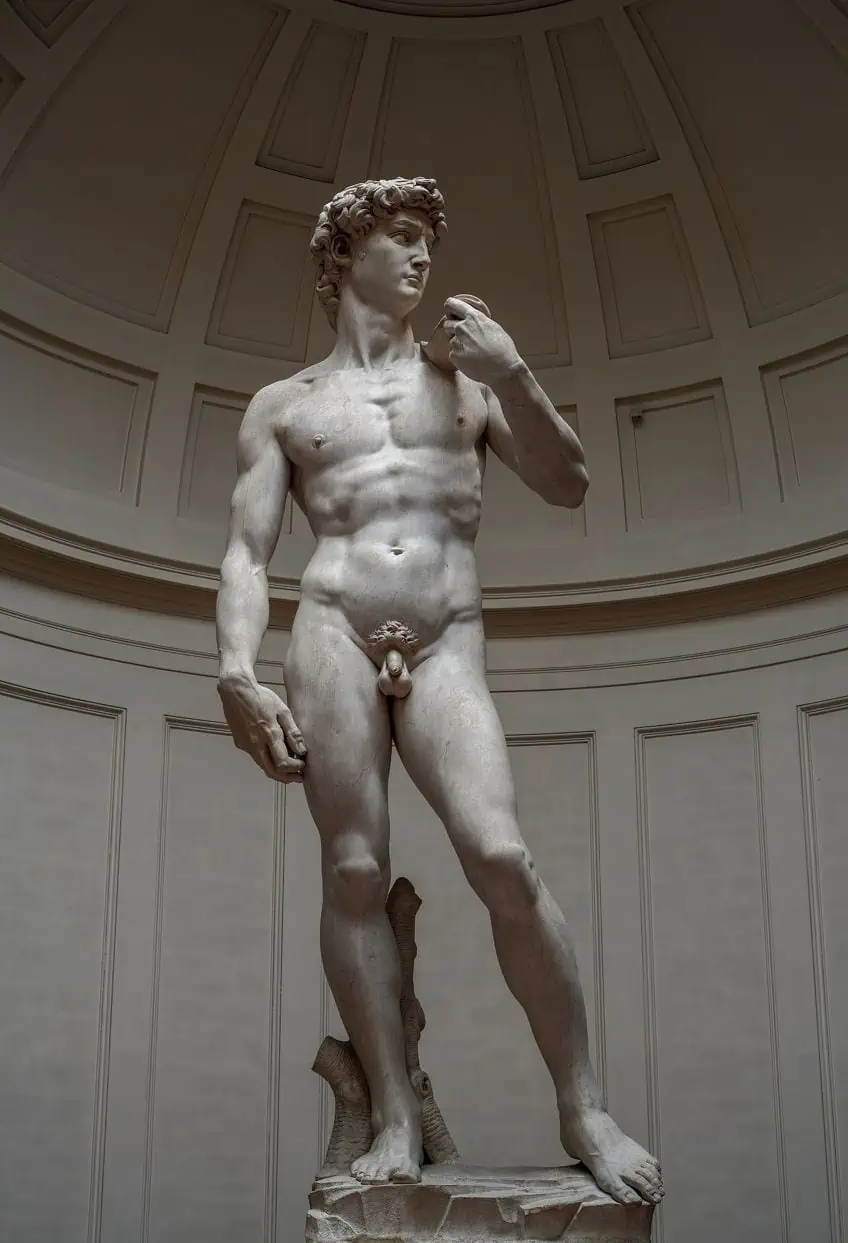
The word “contrapposto” was derived from the Italian words “contrapporre‘ and “postura“, which mean “counterpose” and “posture”. The contrapposto pose was seen as a sculptural approach to create a sense of naturalism and fluidity when illustrating the human form. When applied to statues as seen in David, the pose is illustrated as a figure with the majority of its weight placed on one leg, which causes the torso to shift and appear as though the figure is caught mid-movement. This naturalistic technique was commonly executed with one leg bent at the knee with the figure’s shoulders and hips bent in the opposite direction. Including such a pose in the statue of David gives the viewer the impression that captures the hero in his imagined moving state and brings the statue to life through the dynamic tension cast by contrapposto. Michelangelo, like many sculptors of the 16th century, admired the works of Classical Greek artists and attempted to emulate the essence of ancient Greek Classical sculpture in the Renaissance.
The contrapposto pose also became an important sculptural tool for artists and sculptors to add more realism to the artwork while maintaining accuracy.
The Subtle Victory
What is the statue of David holding? The triumph of David’s battle with Goliath was further unpacked in the subtle nature by which Michelangelo represented the tool that was used to conquer the giant. The theme of subtle victory and resourcefulness was emphasized by the almost invisible slingshot that David appears to carry over his shoulder. In his right hand, he clutches the stone that was used to make the final blow. The slingshot was wrapped around the figure with such ingenuity regarding its subtleness and materiality concerning David’s body that it amplifies the sculpture’s perfect nature.

The slingshot is also symbolic of David’s character in the story as a man who did not employ brute and violence but leveraged his mind and resourcefulness to gain victory over the impossible. Through such delicate sculpture techniques and meticulous thought given to the character, story, and visual representation, Michelangelo sculpted one of the best statues to date.
High Renaissance Interpretations of David and Goliath
It is important to review the significance of biblical subjects such as the story of David and Goliath during the High Renaissance. The story of David and Goliath was among the most popular narratives from the bible, which had also been explored countless times in art history, especially in Italy. According to Renaissance biblical accounts, David was a young shepherd who defeated the Philistine giant named Goliath using only a sling and a stone. In Renaissance artworks, the narrative was reimagined and created in different ways. The most popular traditional depiction of the narrative included dynamic and dramatic elements that emphasized the movement of the figures and the conflict through details on the figure’s body.
Many artists of the Italian High Renaissance took the opportunity to portray David as the heroic figure that he was and emphasized his courage and power in facing a giant, who seemed invincible.
Others chose to emphasize the physical attributes of David, focusing on his muscles and recreating his character, as seen in David, as a tall, towering, and imposing figure. Michelangelo’s David differed from other sculptures since other statues of David featured the character as unassuming, and small, or placed an emphasis on the psychological aspects of the character and his opponent.

This broadened the exploration of themes such as oppression, evil, faith, and courage by psychologically pitting good and evil in the face of each other. David can also be interpreted as a metaphor for the struggles of individuals against powerful forces, which pushed the ideals of individualism in the Renaissance that many were challenged within the shifting state of society, governance, and education.
Condition and Location of the Statue of David
Before its final resting place, the statue of David by Michelangelo was originally placed at the Piazza della Signoria, which was the main square in Florence. The statue remained at the square for over 300 years since its debut in 1504 and had been exposed to the natural elements, owing to its “wear and tear” aesthetic. In 1873, the statue was relocated to its current location to protect it from any further damage. Where is the statue of David?
Today, the statue of David is on display at the Accademia Gallery in Florence, Italy.
An attack on Michelangelo’s David was made in 1991 when a man named Piero Cannata attempted to destroy the statue with a hammer and caused significant damage to David‘s left foot. Luckily, art restorers managed to remedy the damage and save it from permanent disfiguration using fillers to fix the surface. Cannata was found not guilty of his attack after pleading insanity and was thereafter sent for treatment at a psychiatric facility.
Copies of Michelangelo’s David
It was reported that there are over 30 life-sized copies of the statue of David located around the world. The plaster cast copy of Michelangelo’s David can be found at the Victoria and Albert Museum and is said to feature a detachable fig leaf that was created to censor the statue’s nudity for royal visits. The fig leaf was implemented only after Queen Victoria was shocked by David’s naked form. Since then, many artists have replicated Michelangelo’s David using different materials such as imitation marble fiberglass in an attempt to replicate the sophisticated classical look and feel of the original sculpture.
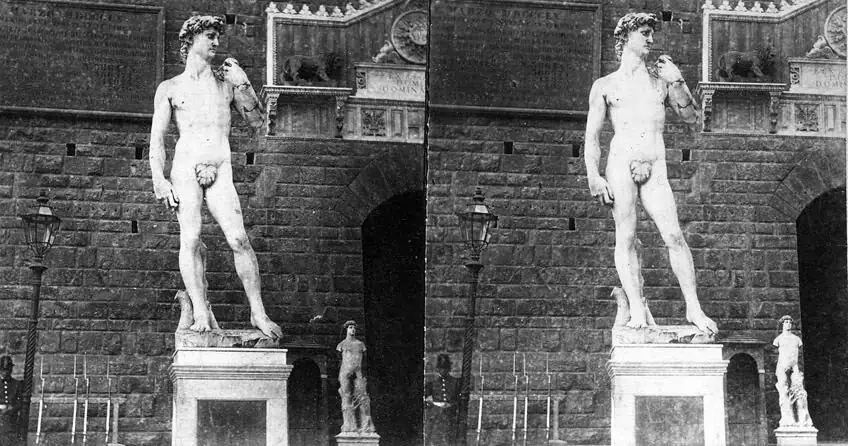
The David statues can be found in many sites around the world, outside of art institutions, including resorts, model railways, and casinos. Additionally, if you are curious about the copies of the David statue you may find yourself wondering “which Las Vegas hotel features a replica of the statue of David?” The Caesar’s Palace hotel in Las Vegas currently holds a replica of Michelangelo’s David in its Appian Way shops, which include other copies of Michelangelo’s work. Despite the replica at the Caesar’s Palace hotel not being an accurate copy, it is still one of the most visited copies of the David statue. The second notable statue of David is located at the Piazzale Michelangelo and is made of bronze.
Other important Michelangelo sculptures produced around the same time frame as the David statue include works like Pietà (1499) and the Madonna of Bruges (1504).
Unveiling Interesting Facts About Michelangelo’s David
Now that you have an in-depth understanding of Michelangelo’s David and its significance in art history, you can now appreciate some of the most interesting facts and details about the statue listed below!
- The original statue of David predated Michelangelo himself! It is known that the project was commissioned by the Opera del Duomo, however, not many know that the project originally commenced in 1464 as part of a series of artworks meant to decorate the Florence cathedral. The project was tasked to Agostino di Duccio, who was capable but seen as inexperienced in the field to work with the large block of marble. He traveled to Carrara to acquire the marble, however, the block he chose was too narrow and riddled with imperfections. His attempt was unsuccessful, but later, the group employed the help of Antonio Rossellino who was also unsuccessful in the project. The same block lay collecting dust in the courtyard for almost 25 years before Michelangelo took the reins. It can thus be said that the material itself waited for the true master of sculpture to release David from the marble.
- The original David statue is imperfectly perfect. Given that the original marble was already in a state of use before Michelangelo started working on the sculpture, one can celebrate the fact that the statue is perfect for its triumph over an imperfection in its material. Michelangelo’s mastery over proportion was well-known, but he was presented with a material that was already carved with imperfections, which made it a high-stakes challenge considering the material was marble. Michelangelo purposefully altered the proportions to appear more emotionally strong when viewed from below and as such, the statue remains technically disproportionate. The deliberate artistic intention behind this stemmed from a “work with what you have” perspective, which despite the challenge, resulted in one of his best works. Michelangelo’s exaggeration of David’s brow and enlarged right hand were also intentional choices used to emphasize David’s strength and evoke the character’s biblical nickname manu fortis.
- Michelangelo was a tradition-breaker in sculpture. While traditional depictions of David in sculpture feature the head of Goliath as a symbol of victory, Michelangelo’s David negated it. Biblical narratives also tended to focus on Goliath’s head, which fell to David’s feet as the main moment of victory, but Michelangelo’s interpretation focuses on the victory that occurred on an intellectual level. In this way, he broke from tradition by presenting David as an alert figure while sticking with the classical contrapposto pose to promote the Renaissance ideal view that victories extended beyond brute strength and could be credited to confidence and intellect.
- The Michelangelo statue was damaged at least several times, including the 1991 hammer attack. Subject to weathering, pigeons, and natural disasters, the statue was also met with stones and scratches during its first year of public exhibition. In 1527, protesters who were rioting against the Medici family also damaged the statue when a bench was hauled from a window, which shattered the figure’s left arm into three pieces.
- Michelangelo’s David is cross-eyed. The famous statue of David is, in fact, cross-eyed and believed to be an intentional gesture on Michelangelo’s part. Since the sculpture was based on the founding principles of Roman sculpture and depictions of the mythical hero Hercules, it has been speculated that Michelangelo purposefully sculpted this “flaw” to pay respect to the masters of Roman sculpture, such that his talents did not attempt to outshine the early masters of perfection.
- Michelangelo created David in secret. According to archive documents, Michelangelo did not reveal his process or efforts until he was finished with the masterpiece. He sculpted in secret until January 1504, and even worked in the rain! It is speculated that he created a wax model for the design of David that he submerged in water. When the water levels dropped, he employed different chisels and tools to sculpt David out of the marble. Michelangelo also did not get too much sleep and was reported to have fallen asleep, often, in his clothes and shoes while rarely eating. After the statue was complete, it was unveiled to only the members of the Vestry Board and Pier Soderini, who was the gonfaloniere of the Republic.
- The original placement of the statue was a collective artistic decision. After the completion of David, a committee was organized to decide on a better location for the statue because it was deemed “too perfect” for the originally planned location at the cathedral. Members of the committee included master artists such as Giuliano da Sangallo, Leonardo da Vinci, and Sandro Botticelli, who convened along with the city council to make an informed artistic decision. The debate for the new location was long-winded and up to nine locations were Finally, the council settled on the center of Florence such that the statue became a symbol of the city’s beauty.
- Transporting David required 40 men and four days to successfully move the statue from Michelangelo’s studio to the Palazzo Vecchio despite the distance between the sites being under a mile.
 David (1504) by Michelangelo; Michelangelo, CC BY-SA 4.0, via Wikimedia Commons
David (1504) by Michelangelo; Michelangelo, CC BY-SA 4.0, via Wikimedia Commons
The Michelangelo statue of David remains an iconic piece of art history that continues to inspire and captivate many. The significance of this iconic masterpiece lies not only in its technical prowess and beauty, but also in its representation of powerful themes such as human strength and idealized beauty, which were the height of Renaissance ideals and concepts. The unique features of David, such as the exaggerated proportions, intense emotive features, and classical aesthetic elevate Michelangelo’s work by setting it apart from other representations of David. As such, the allure of the statue’s material and debate over its placement only makes the statue a testament to the ability of art to inspire others across centuries.
Take a look at our David statue webstory here!
Frequently Asked Questions
Who Created the Original Statue of David?
The original statue of David was created by Italian High Renaissance sculptor and interdisciplinary artist, Michelangelo Buonarotti, between 1501 and 1504. The statue was commissioned in the latter half of the 15th century, and was previously worked on by Agostino di Duccio and Antonio Rossellino before Michelangelo was commissioned to complete it.
What Is the Statue of David by Michelangelo Made From?
The statue of David by Michelangelo was sculpted using Carrara marble, which is a type of white marble with hints of blue-gray veins that are commonly used in sculpture and decor.
Where Is the Statue of David Located?
The statue of David is located in the Florence Accademia Gallery in Italy, alongside two other important copies of the original David situated in the Piazza della Signoria and the center of the Piazzale Michelangelo.
How Tall Is the Statue of David by Michelangelo?
The statue of David by Michelangelo is approximately 17 feet or 5.17 meters tall. The purpose of the statue’s towering height was to amplify the figure of David for viewers when viewing the sculpture from below. The figure was intended for mass viewing in a large space and it was, therefore, necessary that Michelangelo produced a large enough artwork.
What Is the Statue of David Holding?
The statue of David is a figure holding a slingshot in its left hand and a stone in its right hand. These were considered important symbols that defined the biblical character David and the legend of his victory over the giant Goliath.
Which Las Vegas Hotel Features a Replica of the Statue of David?
The hotel that features a replica of the statue of David by Michelangelo is the luxury hotel and casino called Caesar’s Palace hotel, located in Las Vegas, Nevada.
Jordan Anthony is a Cape Town-based film photographer, curator, and arts writer. She holds a Bachelor of Art in Fine Arts from the University of the Witwatersrand, Johannesburg, where she explored themes like healing, identity, dreams, and intuitive creation in her Contemporary art practice. Jordan has collaborated with various local art institutions, including the KZNSA Gallery in Durban, the Turbine Art Fair, and the Wits Art Museum. Her photography focuses on abstract color manipulations, portraiture, candid shots, and urban landscapes. She’s intrigued by philosophy, memory, and esotericism, drawing inspiration from Surrealism, Fluxus, and ancient civilizations, as well as childhood influences and found objects. Jordan is working for artfilemagazine since 2022 and writes blog posts about art history and photography.
Learn more about Jordan Anthony and about us.
Cite this Article
Jordan, Anthony, “Statue of “David” by Michelangelo – A Detailed Analysis.” artfilemagazine – Your Online Art Source. October 20, 2023. URL: https://artfilemagazine.com/statue-of-david-by-michelangelo/
Anthony, J. (2023, 20 October). Statue of “David” by Michelangelo – A Detailed Analysis. artfilemagazine – Your Online Art Source. https://artfilemagazine.com/statue-of-david-by-michelangelo/
Anthony, Jordan. “Statue of “David” by Michelangelo – A Detailed Analysis.” artfilemagazine – Your Online Art Source, October 20, 2023. https://artfilemagazine.com/statue-of-david-by-michelangelo/.


